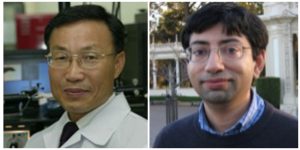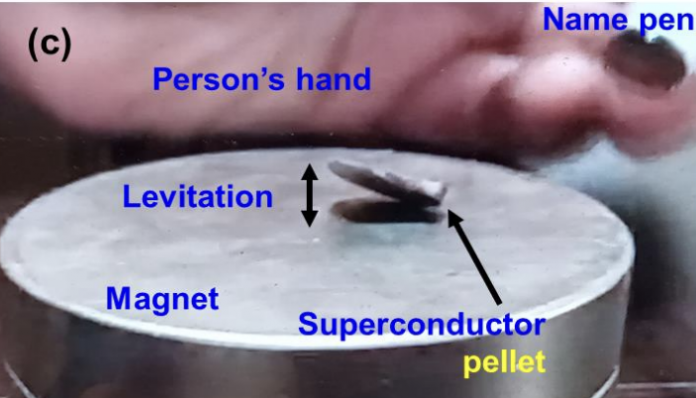College of William and Mary Professors of Physics Hyun-Tak Kim and Mumtaz Qazilbash are involved in potentially groundbreaking superconductor research in collaboration with the South Korea-based Quantum Energy Research Centre. If replicable, the material — a compound made up of lead, oxygen, copper and phosphorus labeled “LK-99” — could enable various technological innovations, including levitating trains and fusion energy projects. The professors are coordinating with the researchers in South Korea and the College administration to bring a sample of the material synthesized by the Research Centre to Williamsburg and analyze it in the coming weeks.
On Saturday, July 22, Kim, a research professor of physics at the College, submitted a pre-print paper titled “Superconductor Pb10−xCux(PO4)6O showing levitation at room temperature and atmospheric pressure and mechanism” to the open-access website arXiv. This pre-print paper, along with another paper published by Young-Wan Kwon, a former member of the Research Centre, and submitted to arXiv just a few hours earlier, launched a buzz in the scientific community.
“There is considerable excitement in the condensed matter physics and materials science communities about possible superconductivity in LK-99,” Qazilbash wrote in an email to The Flat Hat. The creation of such a superconductor that functions in room temperature and ambient pressure conditions has been a pinnacle goal for the superconducting field for over a century.

“The mechanism of a superconductor…[has been a problem for] 110 years,” Kim told The Flat Hat. “[In] 1992 I entered a PhD course. At that time, I decided to resolve the superconductor mechanism challenge.”
Kim said he first gained the attention of researchers at the Quantum Energy Research Centre in November 2021 after publishing an article on a novel mechanism for inducing superconductivity. At the time, he was working at the Electronics and Telecommunications Research Institute in South Korea. Kim later joined the College community in November 2022.
After publishing the initial findings of LK-99 in a Korean journal in April 2023, the Research Centre asked Kim to help them with the English version of the paper, leading him to write what became the pre-print submitted to arXiv. He also submitted it to the journal APL Materials, where it is waiting for peer-review. The paper lists five authors alongside Kim, all of whom are affiliated with the Quantum Energy Research Centre. During the writing process, Kim consulted Qazilbash for comments on the paper before its submission.
While the material was synthesized in South Korea, Kim said the South Korean researchers are sending a batch of LK-99 to Williamsburg that he expects to arrive sometime in August. At that point, he will analyze the sample alongside Qazilbash using spectroscopy.
“Dr. Hyun-Tak Kim and I are in the midst of a formal process for obtaining samples of LK-99 from the South Korean research group so that we can perform additional experiments in labs in Small Hall and elsewhere on the W&M campus,” Qazilbash said in an email to The Flat Hat. “In the formal process for obtaining samples, we are being supported by the relevant W&M administrative offices.”
The recent news regarding the superconductor has sparked controversy. Journal retractions of superconductor research, including a 2022 Nature journal retraction of a sensational result by University of Rochester physicist Ranga Dias, have challenged breakthrough claims. Many experts have also expressed skepticism about the LK-99’s superconductivity.
College physics professor Enrico Rossi told The Flat Hat that he was “surprised” when he heard about the potential superconductor breakthrough. As a theorist, he declined to comment on the experimental results, but stated that he was skeptical of the theoretical claims regarding how the superconductivity mechanism works.
“It doesn’t look sound to me and it is not convincing,” Rossi said.
“It doesn’t look sound to me and it is not convincing,” Rossi said.
Qazilbash is slightly more optimistic, but still cautious. When asked how strongly he believes in the claims of LK-99’s superconductivity, Qazilbash emphasized the need for additional analysis.
“Good science does not operate in the realm of belief, but rather ought to always seek independent confirmation, verification, and reproduction of early results,” Qazilbash said in an email.
“Good science does not operate in the realm of belief, but rather ought to always seek independent confirmation, verification, and reproduction of early results,” Qazilbash said in an email.
There is also conflict between authors affiliated with the research. Just two and a half hours before Kim submitted his six-author paper, Kwon, who was affiliated with the Quantum Energy Research Centre and worked with the team until this past winter, submitted a similar paper to arXiv titled “The First Room-Temperature Ambient-Pressure Superconductor.” This paper only listed three authors, Sukbae Lee, Ji-Hoon Kim, and Kwon himself. Three authors is the upper limit for a Nobel Prize.
In an email, Kim told The Flat Hat that Kwon submitted the three-author paper without Lee or Ji-Hoon Kim’s permission. Kim also asserted that this submission was wholly based on the previously published article in a Korean journal, and had since been rejected by a high-impact journal.
“Contents of the paper uploaded by Prof. Kwan is the same as that published in the Korean Journal, that is, has no advancement; this is dual publishment [sic] and self-fraud, because the Korean journal was not cited,” Kim wrote.
Kim said he believes that Kwon will face punishment for this action and that the three-author paper might be removed from arXiv.
“Prof. Kwan was brought to Research-Truth Committee [sic] to receive trials in his affiliated university and Koraen [sic] National Science Foundation (NSF),” Kim wrote. “I think the paper uploaded by Prof. Kwan will be withdrawn by the committee and punished. Administration team of arXiv mentioned in the uresponse [sic] mail of our request that we will withdraw it, when the president of his affiliated university makes a decision of its withdraw.”
Kwon did not respond to requests for comment by the time of publication.
A few days earlier, on Monday, July 17, Kim wrote to Lee to get permission from all of the authors by July 19 to publish the six-author paper, which, according to Kim, includes more precise measurements and explanations than the three-author paper. Kim asserts that Lee wanted to include Kwon on the author list when, according to Kim, Kwon’s contribution was limited.
All of the authors agreed to the paper’s submission to the APL Materials journal and arXiv except for Kwon, who requested more time. Kim waited for Kwon’s decision until the weekend when he received word from Lee that Kwon still did not give permission. After that, Kim removed Kwon’s name from the paper and submitted the six-author paper to APL Materials and onto arXiv. Just a few hours earlier, Kwon had submitted the three-author paper to arXiv without the permission of the other authors.
Kim says they are now waiting for the six-author paper to be peer-reviewed and published in APL Materials. In the meantime, he believes the material can be replicated within a month.
“[While] more research is necessary, the future is bright,” Kim said.


[…] Student News […]
[…] with the Flat Hat, a pupil newspaper from the School of William and Mary, Korean researchers are sending some LK-99 samples on to physics professors at Virginia College. So keep […]
[…] to the Flat Hat, a student newspaper from the College of William and Mary, Korean researchers are sending some LK-99 samples directly to physics professors at Virginia University. So stay […]
[…] to the Flat Hat, a student newspaper from the College of William and Mary, Korean researchers are sending some LK-99 samples directly to physics professors at Virginia University. So stay […]
[…] to the Flat Hat, a student newspaper from the College of William and Mary, Korean researchers are sending some LK-99 samples directly to physics professors at Virginia University. So stay […]
[…] to the Flat Hat, a student newspaper from the College of William and Mary, Korean researchers are sending some LK-99 samples directly to physics professors at Virginia University. So stay […]
[…] to the Flat Hat, a student newspaper from the College of William and Mary, Korean researchers are sending some LK-99 samples directly to physics professors at Virginia University. So stay […]
[…] to the Flat Hat, a student newspaper from the College of William and Mary, Korean researchers are sending some LK-99 samples directly to physics professors at Virginia University. So stay […]
[…] Laut Flat Hat, einer Studentenzeitung des College of William and Mary, sind es koreanische Forscher Senden Sie einige LK-99-Proben direkt an Physikprofessoren der Virginia University. Also bleibt […]
I never seen the technical paper that is published like this case. Does W&M has an advanced physics research facility to do this research? Where Prof Kim received an intensive training on this subject? Did Prof Kim received the LK99 material from Korea (it said in mid-August)? I worked in this field more than 30 years and I am still not fully understand how this superconductivity is discovered.